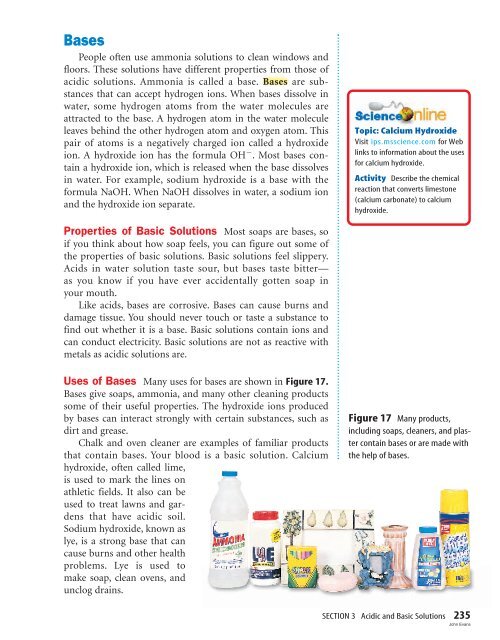Substances, Mixtures, and Solubility - McGraw-Hill Higher Education
Substances, Mixtures, and Solubility - McGraw-Hill Higher Education
Substances, Mixtures, and Solubility - McGraw-Hill Higher Education
Create successful ePaper yourself
Turn your PDF publications into a flip-book with our unique Google optimized e-Paper software.
Bases<br />
People often use ammonia solutions to clean windows <strong>and</strong><br />
floors. These solutions have different properties from those of<br />
acidic solutions. Ammonia is called a base. Bases are substances<br />
that can accept hydrogen ions. When bases dissolve in<br />
water, some hydrogen atoms from the water molecules are<br />
attracted to the base. A hydrogen atom in the water molecule<br />
leaves behind the other hydrogen atom <strong>and</strong> oxygen atom. This<br />
pair of atoms is a negatively charged ion called a hydroxide<br />
ion. A hydroxide ion has the formula OH . Most bases contain<br />
a hydroxide ion, which is released when the base dissolves<br />
in water. For example, sodium hydroxide is a base with the<br />
formula NaOH. When NaOH dissolves in water, a sodium ion<br />
<strong>and</strong> the hydroxide ion separate.<br />
Topic: Calcium Hydroxide<br />
Visit ips.msscience.com for Web<br />
links to information about the uses<br />
for calcium hydroxide.<br />
Activity Describe the chemical<br />
reaction that converts limestone<br />
(calcium carbonate) to calcium<br />
hydroxide.<br />
Properties of Basic Solutions Most soaps are bases, so<br />
if you think about how soap feels, you can figure out some of<br />
the properties of basic solutions. Basic solutions feel slippery.<br />
Acids in water solution taste sour, but bases taste bitter—<br />
as you know if you have ever accidentally gotten soap in<br />
your mouth.<br />
Like acids, bases are corrosive. Bases can cause burns <strong>and</strong><br />
damage tissue. You should never touch or taste a substance to<br />
find out whether it is a base. Basic solutions contain ions <strong>and</strong><br />
can conduct electricity. Basic solutions are not as reactive with<br />
metals as acidic solutions are.<br />
Uses of Bases Many uses for bases are shown in Figure 17.<br />
Bases give soaps, ammonia, <strong>and</strong> many other cleaning products<br />
some of their useful properties. The hydroxide ions produced<br />
by bases can interact strongly with certain substances, such as<br />
dirt <strong>and</strong> grease.<br />
Chalk <strong>and</strong> oven cleaner are examples of familiar products<br />
that contain bases. Your blood is a basic solution. Calcium<br />
hydroxide, often called lime,<br />
is used to mark the lines on<br />
athletic fields. It also can be<br />
used to treat lawns <strong>and</strong> gardens<br />
that have acidic soil.<br />
Sodium hydroxide, known as<br />
lye, is a strong base that can<br />
cause burns <strong>and</strong> other health<br />
problems. Lye is used to<br />
make soap, clean ovens, <strong>and</strong><br />
unclog drains.<br />
Figure 17 Many products,<br />
including soaps, cleaners, <strong>and</strong> plaster<br />
contain bases or are made with<br />
the help of bases.<br />
SECTION 3 Acidic <strong>and</strong> Basic Solutions 235<br />
John Evans

















